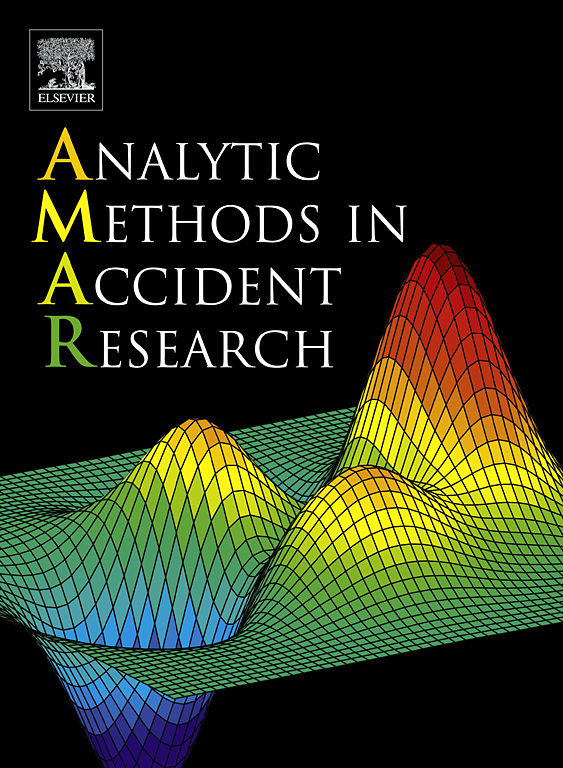样本量对使用极值模型从交通冲突中估算行人碰撞风险的影响
IF 12.6
1区 工程技术
Q1 PUBLIC, ENVIRONMENTAL & OCCUPATIONAL HEALTH
引用次数: 0
摘要
在估计交通冲突造成的碰撞风险的极值理论(EVT)模型中,样本量起着至关重要的作用。许多研究都对样本量及其对 EVT 模型性能的负面影响表示担忧。然而,样本量对 EVT 模型的影响并不为人所知,这就需要对样本量对模型性能的影响进行广泛调查和深入了解。受这一研究空白的启发,本研究提出了一种系统的方法来研究样本大小对 EVT 模型的影响,旨在估算交通冲突造成的行人碰撞风险。本研究从澳大利亚布里斯班三个信号灯控制交叉路口收集的共计 144 小时的视频数据中提取了十个较小的同质交通冲突样本,其中车辆与行人的冲突是通过后侵占时间来测量的。为确保每个子集包含来自三个交叉路口的相同数据,使用均匀分布形成样本,并使用贝叶斯框架中估计的非平稳块最大值和峰值超过阈值模型对其影响进行测试。结果表明,样本大小会影响平均碰撞频率、置信区间和相对误差的预测。虽然样本量的影响并不均匀,但随着样本量的增加,模型的性能似乎有所改善,其中块最大值模型对样本量变化的敏感性更高,而峰值超过阈值模型的性能相对稳定且更好。此外,对样本量阈值的比较表明,峰值超过阈值的方法比其对应方法更具成本效益。总之,本研究的结果表明,样本量不当会导致可预测性差、可靠性低和不确定性大。本文章由计算机程序翻译,如有差异,请以英文原文为准。
Effects of sample size on pedestrian crash risk estimation from traffic conflicts using extreme value models
Sample size plays a critical role in an Extreme Value Theory (EVT) model for estimating crash risks from traffic conflicts. Many studies have raised concerns regarding sample size and its consequent negative impact on the performance of EVT models. However, the effects of sample size on EVT models are not well-known, requiring an extensive investigation and a deeper understanding of the effects of sample size on model performance. Motivated by this research gap, this study proposes a systematic approach to examine the effects of sample size on EVT models aimed at estimating pedestrian crash risks from traffic conflicts. Ten smaller and homogeneous samples of traffic conflicts are derived from a total of 144 h of video data collected from three signalised intersections in Brisbane, Australia, whereby vehicle–pedestrian conflicts are measured by post encroachment time. To ensure that each subset contains equal data from three intersections, samples are formed using a uniform distribution, and their effects are tested using non-stationary Block Maxima and Peak Over Threshold models estimated in the Bayesian framework. Results show that the sample size influences the prediction of mean crash frequencies, confidence intervals, and relative errors. Although the effect of sample size is non-uniform, the model performance appears to improve with the increase in sample size, whereby the block maxima models show higher sensitivity towards sample size variation, and the peak over threshold models reveal relatively stable and better performance. Moreover, a comparison of sample size thresholds indicates that the peak over threshold approach is more cost-efficient than its counterpart. Overall, the findings of this study demonstrate that improper sample size can lead to poor predictability, low reliability, and large uncertainties.
求助全文
通过发布文献求助,成功后即可免费获取论文全文。
去求助
来源期刊

Analytic Methods in Accident Research
Multiple-
CiteScore
22.10
自引率
34.10%
发文量
35
审稿时长
24 days
期刊介绍:
Analytic Methods in Accident Research is a journal that publishes articles related to the development and application of advanced statistical and econometric methods in studying vehicle crashes and other accidents. The journal aims to demonstrate how these innovative approaches can provide new insights into the factors influencing the occurrence and severity of accidents, thereby offering guidance for implementing appropriate preventive measures. While the journal primarily focuses on the analytic approach, it also accepts articles covering various aspects of transportation safety (such as road, pedestrian, air, rail, and water safety), construction safety, and other areas where human behavior, machine failures, or system failures lead to property damage or bodily harm.
 求助内容:
求助内容: 应助结果提醒方式:
应助结果提醒方式:


